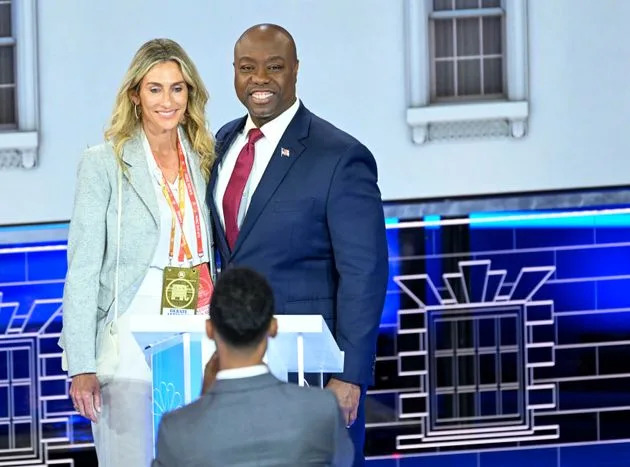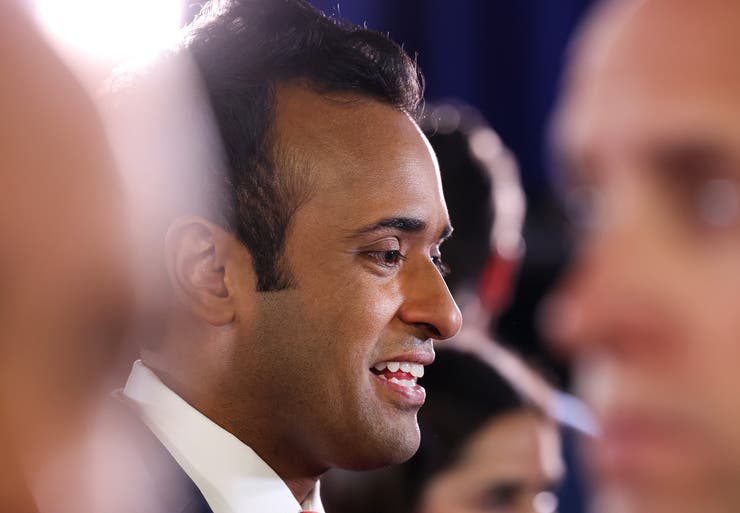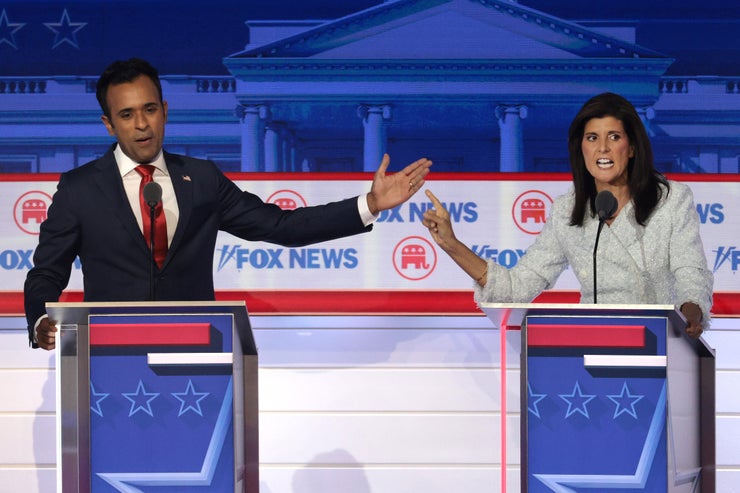Appeals court forces Biden admin to hold offshore oil lease sale without eco restrictions
Thomas Catenacci
Tue, November 14, 2023
A federal appeals court panel ruled in favor of energy industry groups in an order Tuesday evening requiring the Biden administration to hold a massive offshore oil and gas lease sale without eco restrictions.
The 5th Circuit Court of Appeals ruled in the decision that the Department of the Interior's Bureau of Ocean Energy Management (BOEM) must move forward with Lease Sale 261, a large Gulf of Mexico oil and gas lease sale mandated under the Inflation Reduction Act. The sale was originally scheduled for September, but was postponed after BOEM implemented last-minute environmental restrictions.
"Energy independence scored an important win tonight with the Fifth Circuit decision lifting unjustified restrictions on oil and natural gas vessels and restoring acreage for offshore energy development," American Petroleum Institute (API) Senior Vice President and General Counsel Ryan Meyers said in a statement.
"The U.S. Gulf of Mexico plays a critical role in maintaining affordable, reliable American energy production, and today’s decision creates greater certainty for the essential energy workforce and the entire Gulf Coast economy," he continued.

The Biden administration was sued by the fossil fuel industry and Louisiana after it entered into a settlement with environmental groups and restricted Lease Sale 261.
The ruling Tuesday upholds a lower court decision which struck down the federal government's late modification of Lease Sale 261. BOEM added environmental restrictions to the sale and blocked off millions of acres previously scheduled to be leased during the sale in August, one month after the government entered into a federal stipulated stay agreement with environmental advocacy organizations.
The July settlement with environmental groups came after years of litigation and specifically expands protections for the Rice’s whale, a species listed as endangered. However, the appeals court ultimately ruled that delaying Lease Sale 261 wouldn't protect the species which has rarely been located near the leases offered in the sale.
"At least one whale would need to traverse the area in which oil-and-gas activities are occurring under Lease Sale 261 and be killed by such activities," the appeals panel decision states. "But in four separate environmental reviews over the last seven years, BOEM concluded that additional protections for the Rice’s whales are unnecessary outside of their ‘core’ habitat in the eastern Gulf — an area unrelated to Lease Sale 261 that has long been protected from oil-and-gas leasing."
"At least one member of an Intervenor organization would need to go sight-seeing in the Rice’s whale’s habitat with intent to see the Rice’s whale after its population is diminished — events the dates of which remain unknown," it continues.

An offshore drilling and production platform is photographed in the Gulf of Mexico 200 miles southwest of Houston, Texas.The Biden administration moved to restrict Lease Sale 261 to 67 million acres, less than the 73.4 million acres it originally was slated to offer. Under Tuesday's ruling, the administration must move forward with the 73.4 million-acre plan.
After BOEM issued its Lease Sale 261 restrictions in August, API, which is the nation's largest fossil fuel industry group, alongside the State of Louisiana and U.S. oil company Chevron, sued BOEM after the agency issued its Lease Sale 261 notice of sale, which made six million fewer acres available to oil and gas extraction than previously scheduled, as part of a settlement with eco groups.
The agency also created multiple vessel restrictions for companies that obtain leases.
Then, on Sept. 21, Judge James Cain of the Western District of Louisiana granted a preliminary injunction to plaintiffs and ordered the Biden administration to proceed with Lease Sale 261 without restrictions. After the government appealed, the appeals court allowed BOEM to delay the sale until Nov. 8.
And late last month, the appeals panel issued a stay on the lower court's preliminary injunction. As a result, BOEM announced on Nov. 2 that it would indefinitely postpone the sale, a move criticized by bipartisan lawmakers including Senate Energy and Natural Resources Committee Chairman Joe Manchin, D-W.Va.
Under the appeals court ruling Tuesday, BOEM is required to hold the sale within 37 days.

Senate Energy and Natural Resources Committee Chairman Joe Manchin, D-W.Va., said last month that the Biden administration had "made a complete mess of Lease Sale 261."
"The court's ruling is a necessary and positive response to an unwarranted decision by the Biden administration," said Erik Milito, the president of the National Ocean Industries Association. "The removal of millions of highly prospective acres, along with the imposition of excessive restrictions, resulted from a voluntary agreement with activist groups that sidestepped legal processes, disregarded scientific considerations, and neglected public input."
"The escalating geopolitical tensions and instability in various oil-producing regions emphasize the critical role of the U.S. Gulf of Mexico," he continued. "To fortify our national security stance, it is essential to champion strength and support U.S. oil and gas production."
Milito added that the ruling Tuesday stands in contrast to federal policies like easing oil sanctions on Venezuela and Iran which are actions, he argued, "that could contribute to heightened global unrest."
"Fully leveraging America's energy production capabilities, especially our offshore resources, is imperative to address some of our nation's most pressing challenges," he said.
BOEM didn't immediately respond to a request for comment.
Lease of Gulf waters delayed by whale protection debate must continue, court rules
KEVIN McGILL
Updated Tue, November 14, 2023

FILE - A rig and supply vessel are pictured in the Gulf of Mexico, off the cost of Louisiana, April 10, 2011. An auction of federal Gulf of Mexico leases for oil and gas drilling must be held in 37 days, a federal appeals court ruled Tuesday, Nov. 14, 2023, rejecting environmentalists arguments against the sale, and throwing out plans by the Biden administration to scale back the sale to protect an endangered species of whale.
The 5th U.S. Circuit Court of Appeals ruling means the lease sale — once set for September, but postponed multiple times amid legal fights — will be held in December. And it must cover 73 million acres (30 million hectares), as originally planned when the administration announced the sale in the spring.
The administration later scaled back the area covered by the lease sale to 67 million acres (27 million hectares) as part of an agreement to protect the endangered Rice’s whale. But the state of Louisiana joined oil and gas companies in opposing the changes.
A federal judge in southwest Louisiana ordered the sale to go on without the whale protections, which also included regulations involving vessel speed and personnel. That led to an appeal by environmental groups — and delays while the arguments continued.
On Tuesday, a 5th Circuit panel rejected the appeal.
Oil industry attorneys disputed that the protections were needed in the area to be leased and said the administration had not gone through legally required procedures to impose the new restrictions.
Industry supporters also had been critical of the Biden administration's handling of the sale, which was ordered in 2022 as part of the Inflation Reduction Act.
An attorney for an environmental group called the ruling “disappointing and unjustified,” in an emailed statement.
“This could be the difference between doing the bare minimum to save this species, and allowing it to vanish,” George Torgun, an attorney for the group Earthjustice, said in a statement.
The American Petroleum Institute, a powerful U.S. oil and gas industry trade association, lauded the development.
“Energy independence scored an important win tonight with the Fifth Circuit decision lifting unjustified restrictions on oil and natural gas vessels and restoring acreage for offshore energy development,'' said Senior Vice President and General Counsel Ryan Meyers.
His statement added that drilling in the Gulf plays a critical role in maintaining “affordable, reliable American energy production" and that the judge's "decision creates greater certainty for the essential energy workforce and the entire Gulf Coast economy.”
Biden Ordered to Sell Gulf Of Mexico Oil Leases Next Month
Jennifer A. Dlouhy
Tue, November 14, 2023

(Bloomberg) -- A federal appeals court ordered the Biden administration to sell drilling rights in the Gulf of Mexico within 37 days, a defeat for environmentalists who argued oil leasing and development in the region imperil a critically endangered whale.
The ruling Tuesday by the Fifth Circuit Court of Appeals means the US Interior Department has until Dec. 20 to conduct the auction that was mandated by last year’s climate law — and is set to be the last of its kind until at least 2025.
When the Interior Department made plans to conduct the sale in September, it yanked some 6 million acres from the auction block amid concerns the territory overlapped with potential habitat of the critically endangered Rice’s whale. The agency also imposed vessel traffic limitations in the area — moves that were challenged by the oil industry in federal court.
The court found environmental organizations didn’t have standing to appeal earlier rulings compelling the auction with the disputed acreage and without the vessel traffic restrictions.
Earthjustice attorney George Torgun said the dismissal was “disappointing and unjustified.”
“The oil industry fought tooth and nail to tear up basic measures to save one of the most endangered marine mammals in the world,” Torgun said in an emailed statement. “This could be the difference between doing the bare minimum to save this species and allowing it to vanish.”
The decision was heralded by the American Petroleum Institute, which pushed for the larger auction alongside units of Chevron Corp. and Shell Plc.
“The US Gulf of Mexico plays a critical role in maintaining affordable, reliable American energy production,” said Ryan Meyer, API senior vice president, in an emailed statement. The decision, he added, “creates greater certainty for the essential energy workforce and the entire Gulf Coast economy.”
The Biden administration did not challenge the lower court order that compelled the auction — and only asked for more time to comply with it. The granted 37 days are designed to allow time for the publication of a new sale notice in the government’s Federal Register and accept new sealed bids for Gulf leases.
©2023 Bloomberg L.P.
Court dismisses effort to restrict Gulf drilling over endangered whale
Rachel Frazin
Tue, November 14, 2023

A federal appeals court has dismissed an effort from environmental groups to prevent an oil rights drilling auction from proceeding without protections for an endangered species of whale.
Instead, the 5th Circuit Court of Appeals ruled the Biden administration will have 37 days to carry out the auction for rights to drill in the Gulf of Mexico.
The litigation stems from action by the Biden administration that would have put stipulations on an upcoming oil and gas lease sale auction in the Gulf as part of an effort to protect the Rice’s Whale.
The administration said in August that it would shrink the sale and restrict ship activity in order to protect the whale, of which there are believed to be fewer than 100 remaining.
Chevron, the state of Louisiana and an oil and gas lobbying group sued over that action, and a lower court ruled in their favor, saying that the Biden administration needed to move ahead with the sale in just a few days.
Both the Biden administration and environmental groups appealed the lower court’s move, with the Biden administration asking for more time while environmentalists wanted the restrictions that aimed to protect the whale.
The administration got more time, as it will now have 37 days to carry out the sale.
However, judges Edith Brown Clement, Catharina Haynes and Andrew Oldham, who are Bush and Trump appointees, dismissed the environmental groups’ challenge.
They found that the groups did not have standing in the case because they did not show that they will suffer “certainly impending” injury or that any such issues would likely be resolved by the court.
In response, George Torgun, an attorney with Earthjustice, warned of dire consequences for the whale.
“This disappointing and unjustified ruling could be the death knell for the nearly extinct Rice’s whale,” Torgun said in a written statement.
“The oil industry fought tooth and nail to tear up basic measures to save one of the most endangered marine mammals in the world. This could be the difference between doing the bare minimum to save this species, and allowing it to vanish,” he added.
On the other hand, the oil and gas lobbying group, called the American Petroleum Institute, hailed the court ruling as a win.
“The U.S. Gulf of Mexico plays a critical role in maintaining affordable, reliable American energy production, and today’s decision creates greater certainty for the essential energy workforce and the entire Gulf Coast economy,” said a written statement from Ryan Meyers, the group’s senior vice president and general counsel.













